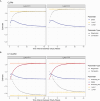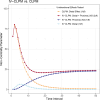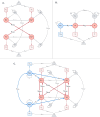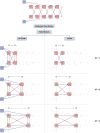Using Instrumental Variables to Measure Causation over Time in Cross-Lagged Panel Models
- PMID: 38358370
- PMCID: PMC11014768
- DOI: 10.1080/00273171.2023.2283634
Using Instrumental Variables to Measure Causation over Time in Cross-Lagged Panel Models
Abstract
Cross-lagged panel models (CLPMs) are commonly used to estimate causal influences between two variables with repeated assessments. The lagged effects in a CLPM depend on the time interval between assessments, eventually becoming undetectable at longer intervals. To address this limitation, we incorporate instrumental variables (IVs) into the CLPM with two study waves and two variables. Doing so enables estimation of both the lagged (i.e., "distal") effects and the bidirectional cross-sectional (i.e., "proximal") effects at each wave. The distal effects reflect Granger-causal influences across time, which decay with increasing time intervals. The proximal effects capture causal influences that accrue over time and can help infer causality when the distal effects become undetectable at longer intervals. Significant proximal effects, with a negligible distal effect, would imply that the time interval is too long to estimate a lagged effect at that time interval using the standard CLPM. Through simulations and an empirical application, we demonstrate the impact of time intervals on causal inference in the CLPM and present modeling strategies to detect causal influences regardless of the time interval in a study. Furthermore, to motivate empirical applications of the proposed model, we highlight the utility and limitations of using genetic variables as IVs in large-scale panel studies.
Keywords: CLPM; Causal inference; instrumental variables; lagged effects.
Figures















Similar articles
-
Appropriate modeling of endogeneity in cross-lagged models: Efficacy of auxiliary and model-implied instrumental variables.Behav Res Methods. 2025 Mar 19;57(4):121. doi: 10.3758/s13428-025-02631-4. Behav Res Methods. 2025. PMID: 40108062
-
A critique of the cross-lagged panel model.Psychol Methods. 2015 Mar;20(1):102-16. doi: 10.1037/a0038889. Psychol Methods. 2015. PMID: 25822208
-
Re-examining the reciprocal effects model of self-concept, self-efficacy, and academic achievement in a comparison of the Cross-Lagged Panel and Random-Intercept Cross-Lagged Panel frameworks.Br J Educ Psychol. 2020 Mar;90(1):77-91. doi: 10.1111/bjep.12265. Epub 2019 Jan 17. Br J Educ Psychol. 2020. PMID: 30657590
-
Time-lagged panel models in psychotherapy process and mechanisms of change research: Methodological challenges and advances.Clin Psychol Rev. 2024 Jun;110:102435. doi: 10.1016/j.cpr.2024.102435. Epub 2024 Apr 27. Clin Psychol Rev. 2024. PMID: 38703437 Review.
-
Causal evidence in health decision making: methodological approaches of causal inference and health decision science.Ger Med Sci. 2022 Dec 21;20:Doc12. doi: 10.3205/000314. eCollection 2022. Ger Med Sci. 2022. PMID: 36742460 Free PMC article. Review.
Cited by
-
Unidirectional and bidirectional causation between smoking and blood DNA methylation: evidence from twin-based Mendelian randomisation.Eur J Epidemiol. 2025 Jan;40(1):55-69. doi: 10.1007/s10654-024-01187-5. Epub 2025 Jan 9. Eur J Epidemiol. 2025. PMID: 39786687 Free PMC article.
-
Long-run causal impact of the 2011 Economic Adjustment Programme on Portuguese population health.PLoS One. 2025 May 30;20(5):e0324756. doi: 10.1371/journal.pone.0324756. eCollection 2025. PLoS One. 2025. PMID: 40446070 Free PMC article.
-
Triangulated evidence provides no support for bidirectional causal pathways between diet/physical activity and depression/anxiety.Psychol Med. 2025 Feb 4;55:e4. doi: 10.1017/S0033291724003349. Psychol Med. 2025. PMID: 39901860 Free PMC article.
-
Unidirectional and Bidirectional Causation between Smoking and Blood DNA Methylation: Evidence from Twin-based Mendelian Randomisation.medRxiv [Preprint]. 2024 Nov 22:2024.06.19.24309184. doi: 10.1101/2024.06.19.24309184. medRxiv. 2024. Update in: Eur J Epidemiol. 2025 Jan;40(1):55-69. doi: 10.1007/s10654-024-01187-5. PMID: 38946972 Free PMC article. Updated. Preprint.
References
-
- Akaike, H. (1974). A new look at the statistical model identification. IEEE Transactions on Automatic Control, 19(6), 716–723. 10.1109/TAC.1974.1100705 - DOI
-
- Allison, P. D., Williams, R., & Moral-Benito, E. (2017). Maximum likelihood for cross-lagged panel models with fixed effects. Socius: Sociological Research for a Dynamic World, 3, 237802311771057. 10.1177/2378023117710578 - DOI
-
- Amin, S., Korhonen, M., & Huikari, S. (2023). Unemployment and mental health: An instrumental variable analysis using municipal-level data for Finland for 2002–2019. Social Indicators Research, 166(3), 627–643. 10.1007/s11205-023-03081-1 - DOI
-
- Andersen, H. K. (2022). Equivalent approaches to dealing with unobserved heterogeneity in cross-lagged panel models? Investigating the benefits and drawbacks of the latent curve model with structured residuals and the random intercept cross-lagged panel model. Psychological Methods, 27(5), 730–751. 10.1037/met0000285 - DOI - PubMed
MeSH terms
Grants and funding
LinkOut - more resources
Full Text Sources
Other Literature Sources
